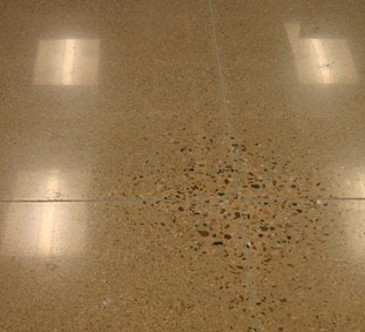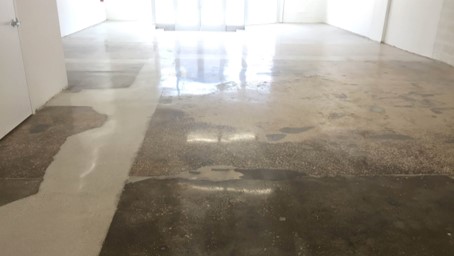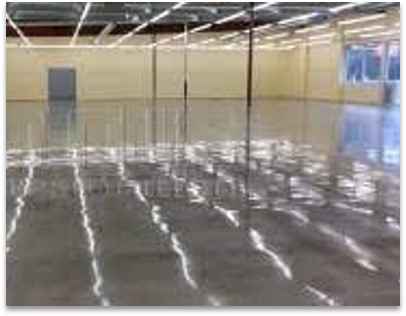Evaluating your floors as a candidate for Polished Concrete
By: Matt Zmich, Director of Concrete Surfaces
Different types of concrete finishes have become increasingly popular. From a decorative stained concrete floor to a natural polish. The aesthetic value of a polished finish on an existing slab provides customers with a beautiful environment that is low maintenance and safe. Its no wonder that finished concrete slabs have been replacing more traditional choices in flooring in commercial, retail, manufacturing, schools, and residential markets. When evaluating your concrete to see if a polished concrete floor is right for you, it’s important to consider what you have and what you can expect from it as a final result.
Basic Explanation of the Process
Simply put, Polished Concrete is a process of grinding, honing, and polishing a concrete surface to smooth the surface to a level of shine that meets the desired amount of gloss and reflectivity. This is accomplished by starting with larger grit, diamond impregnated tooling and progressively going over the surface of the concrete with finer diamond impregnated tooling until the desired amount of gloss and reflectivity is achieved. The result is a floor that highlights all the natural characteristics within that slab of concrete. Its important to remember that this process highlights the character of the concrete, it does not simply grind it away.
What to Consider when Polishing Existing Slabs of Concrete
Whether you are considering a remodel project or taking over an existing building and using polished concrete as your preferred finish, there are a variety of characteristics that you are likely to highlight during the process.
The first thing to look for is if there is an existing floor to remove (Tile, Carpet, LVT, Ceramic etc.). When you remove the flooring, you must determine what process is needed to remove the specific type of flooring and associated equipment to do it correctly. Typically, a ride-on machine that has the right scrapper or tool for cutting away and removing the existing floor is the first step, followed by a more aggressive grind to remove glue, mastic, mortar bed, or even an over layment.
This process will likely expose a larger size of aggregate. When polishing, the more aggressively you grind the floor, the deeper into the aggregate you will polish. In a an existing slab, it is impossible to guarantee a universal aggregate exposure as it is unknown how flat the concrete is, how much grinding it will take to remove glues and thin-sets, and how or where the aggregate was placed when it was poured. These are things we do not have control over in this situation. Another thing to be aware of is that existing tile can leave a ghost like shadow permanently imbedded in the concrete. This shadow, or “ghosting”, is permanent, and no amount of grinding will remove it. This is just part of the character of the concrete that will be highlighted during the process.
Other characteristics to look for in an existing slab are pitting of the concrete, cracks that need to be filled, existing trenches that have been re-poured, and any major and minor patching that needs to be done. Small to fine pitting is typically filled in using a pigmented grout coat of an epoxy or polyurea. The material is flat squeegeed onto the floor after the initial grind, then ground off again leaving the material in the pits. There are several colors to choose from to make it match the floor as close as possible. In large aggregate exposed floors, this can blend in somewhat as a piece of aggregate.
Trenches and different pours of concrete never match the colors and aggregate of the existing floor. These will always stand out. Same as patching. There are several different types of durable and polishable patching materials used to repair damaged concrete however, a patch will always be a patch.
Cracks and control joints are usually chased out and filled with a semi-rigid polyurea joint sealant. This is designed to stretch with the movement of the joint or crack to a certain point and remain as a rigid surface within the joint or crack. At a certain point, if the concrete moves further beyond the elongation rating of the sealant, then the sealant separates from one side to maintain its rigidity. This is by design so that the sealant keeps its surface even with the concrete and prevents traffic from damaging the concrete edges and making the cracks or joints bigger.
What to Consider with New Slabs of Concrete
New slabs of concrete are nice to work on for a variety of reasons. They are poured with a polished concrete finish in mind. This gives you control of the floor flatness and floor levelness. When a floor is flat, then the reflection and uniformity of the polish is at its peak. The reflected ceiling lights are crisp and straight. If the floor is wavy and uneven, the reflected lights will be as well.
With a new, flat concrete slab, you can better control the desired amount of aggregate exposure you desire. Keep in mind that high spots along control joints will often show a little more aggregate exposure than the rest of the field and a certain amount of variation in aggregate exposure is acceptable due to the things that cannot be controlled in the environment.
Control Joints can be placed with a better plan on a new slab of concrete to avoid cracking throughout the field. With an existing slab there is always a chance of dealing with cracks since it was not originally poured with being the finished surface in mind.
Summary
Polished Concrete is a great option to enhance your space. It gives you an industrial, chic look as well as highlighting the bare bones of your structure. Each piece of concrete tells a different story. You can tell the architectural story of your building, whether it’s an old slab full of character, or a brand-new slab carefully crafted, the polishing process can help bring your vision to life.




 2700 Blue Water Road, #400, Eagan, Minnesota 55121
2700 Blue Water Road, #400, Eagan, Minnesota 55121 Main:
Main: 


